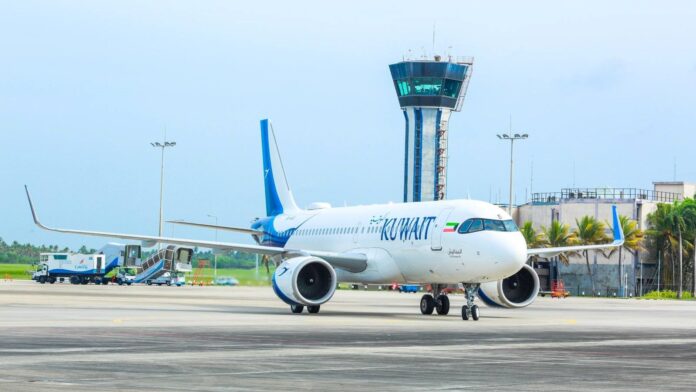A New Boost for Sri Lanka’s Aviation and Tourism Economy
Frontpage Journal | Current Affairs
After a two-year pause in direct operations, Kuwait Airways has officially re-launched its direct flights to Colombo, marking a vital turning point for Sri Lanka’s aviation and tourism industries. The return of one of the oldest international carriers operating to Sri Lanka signifies not merely a resumption of air services but a strengthening of regional connectivity, economic cooperation, and post-crisis revival for the island’s travel sector. The inaugural flight, which landed at Bandaranaike International Airport (BIA) on the 27th of October, was greeted with a ceremonial water cannon salute by Airport and Aviation Services (Sri Lanka) (Private) Limited and a traditional Kandyan dance performance organized by Sri Lanka Tourism, symbolizing the renewal of a long-standing aviation relationship that began more than four decades ago.
Kuwait Airways, the national carrier of the State of Kuwait, first began operations to Sri Lanka in 1978. For many years, the airline served as a vital bridge connecting Colombo to the Middle East and beyond, providing access to thousands of Sri Lankan migrant workers, business travelers, and tourists. After two years of codeshare operations with SriLankan Airlines, the airline’s decision to resume direct services with four weekly flights on the modern Airbus A320neo marks a renewed confidence in Sri Lanka’s aviation potential and economic stability. The reintroduction of direct routes at this juncture carries strategic significance, it reflects both the recovery of air travel demand and Sri Lanka’s gradual re-emergence as a competitive destination in South Asia.
The timing of this re-launch could not be more opportune. Following the pandemic and the island’s recent economic challenges, Sri Lanka’s tourism and aviation sectors have been in a phase of steady rebuilding. Tourism remains one of the key foreign exchange earners for the country, and improved air connectivity is fundamental to sustaining its upward trajectory. The return of Kuwait Airways enhances accessibility from the Middle East, a market that has historically contributed significantly to Sri Lanka’s tourist arrivals. Moreover, the Gulf region is not only a source of leisure travelers but also of business partnerships, investment opportunities, and expatriate movement, all of which are vital to the nation’s broader macroeconomic recovery.
From a business and operational perspective, the airline’s deployment of the Airbus A320neo demonstrates a clear commitment to efficiency, comfort, and sustainability. The A320neo, known for its fuel economy and reduced emissions, aligns well with the growing global emphasis on environmentally responsible aviation. This transition also benefits Sri Lanka’s aviation hub status, as regional airports increasingly compete for carriers that prioritize modern fleet operations. Enhanced aircraft technology translates to greater passenger satisfaction, lower operating costs, and a more stable service model, factors that indirectly support local airport revenue, ground handling operations, and tourism-related businesses.
At the welcoming ceremony, passengers were greeted with Ceylon Tea gifts offered by the Sri Lanka Tea Board, a symbolic gesture that underscores the interlinkage between tourism, trade, and cultural diplomacy. Air connectivity plays a subtle but crucial role in promoting Sri Lanka’s export identity. Each flight not only brings tourists but also carries Sri Lankan goods, brand visibility, and bilateral goodwill to the global market. The event’s ceremonial elements, such as the exchange of mementos between officials and the participation of the tourism authority, signaled that this was more than a commercial arrangement; it was a reaffirmation of international partnership and confidence in Sri Lanka’s future.
For the Sri Lankan aviation industry, Kuwait Airways’ return introduces a wave of optimism. Over the past few years, the country’s air transport sector has faced volatility, from declining inbound tourism to fluctuating fuel prices and foreign currency shortages. Yet, consistent partnerships with long-term carriers like Kuwait Airways provide stability and predictability. They encourage competition, improve route diversity, and reduce dependency on regional hubs. Moreover, having multiple Middle Eastern connections allows Sri Lanka to tap into transfer passengers traveling between Europe, Africa, and Asia, helping BIA to function as a viable connecting hub rather than merely a destination endpoint.
Economically, the multiplier effect of direct air links extends well beyond the aviation sector. Increased passenger inflows translate to higher occupancy rates in hotels, greater business for local tour operators, and stronger demand for transport and hospitality services. The tourism ripple effect stimulates a wide range of industries, from agriculture and handicrafts to retail and entertainment. A steady rise in tourist arrivals, fueled by accessible air services, contributes to foreign exchange inflows and ultimately supports the stabilization of Sri Lanka’s balance of payments. For a country in economic recovery, every new flight is a potential catalyst for renewed investor confidence and consumer spending.
However, such opportunities come with the responsibility of maintaining service quality, infrastructure readiness, and policy consistency. Sri Lanka’s aviation authorities must continue to modernize airport facilities, streamline passenger handling, and strengthen safety and regulatory standards to sustain foreign carriers’ confidence. The island’s position as a tourism hub depends on reliability and competitiveness, and the return of Kuwait Airways should serve as an incentive to accelerate reforms that make Sri Lanka’s airports more efficient and passenger-friendly.
In a broader sense, the re-launch of direct flights also deepens diplomatic and cultural ties between Sri Lanka and Kuwait. Over 120,000 Sri Lankans currently live and work in Kuwait, forming an essential part of the country’s expatriate workforce. For them, direct connectivity means easier travel, lower costs, and stronger personal and economic linkages. On the policy front, such partnerships reinforce bilateral cooperation beyond aviation, extending into trade, investment, and labor relations. The government’s support for the re-launch underscores its recognition that international connectivity is not just about air routes but about long-term national competitiveness.
For industry observers, this development represents a case study in how small nations can rebuild global confidence through consistent engagement and pragmatic strategy. The Sri Lankan tourism and aviation sectors have weathered crises before, from political instability to global pandemics, and each time, recovery has begun with the restoration of trust and connectivity. Kuwait Airways’ return signals that this process is once again underway.
The challenge ahead lies in ensuring that the momentum continues. Sustainable growth in the air travel sector requires cohesive marketing, regional partnerships, and policy alignment between tourism and infrastructure development. As Sri Lanka seeks to reposition itself as a gateway to South Asia, direct routes such as Kuwait–Colombo serve as both a symbol and a tool of national recovery. They embody the country’s enduring appeal, its openness to the world, and its potential to thrive again as a destination of choice for travelers and investors alike.
In the end, the water cannon salute at Bandaranaike International Airport was more than a ceremonial gesture, it was a statement of renewal. It reflected not only the reopening of a route but the rekindling of confidence in Sri Lanka’s skies. Each arriving flight now carries with it more than passengers; it brings opportunity, optimism, and a shared vision for a future where aviation once again serves as the heartbeat of national growth.




